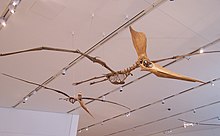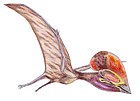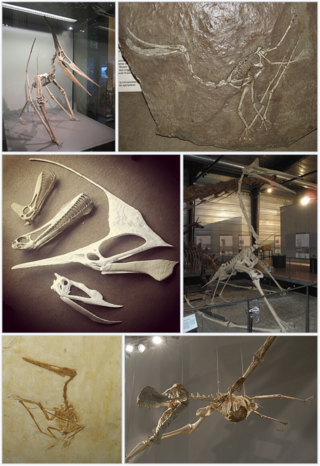
Pterodactyloidea is one of the two traditional suborders of pterosaurs, and contains the most derived members of this group of flying reptiles. They appeared during the middle Jurassic Period, and differ from the basal rhamphorhynchoids by their short tails and long wing metacarpals. The most advanced forms also lack teeth, and by the late Cretaceous, all known pterodactyloids were toothless. Many species had well-developed crests on the skull, a form of display taken to extremes in giant-crested forms like Nyctosaurus and Tupandactylus. Pterodactyloids were the last surviving pterosaurs when the order became extinct at the end of the Cretaceous Period, together with the non-avian dinosaurs and most marine reptiles.

Gallodactylidae is a group of pterosaurs within the suborder Pterodactyloidea. Gallodactylids differed from other related pterosaurs in several distinct features, including fewer than 50 teeth present only in the jaw tips, and rounded crests present on the rear portion of the skull and jaws but not near the ends of their snouts. At least some species possessed jaw flanges, possibly used to bissect hard-shelled prey.
Boreopterus is a genus of boreopterid pterodactyloid pterosaur from the Barremian-Aptian-age Lower Cretaceous Yixian Formation of Dalian, Liaoning, China.
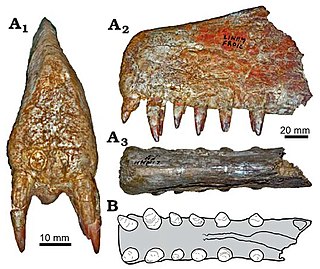
Siroccopteryx is an extinct genus of anhanguerid pterodactyloid pterosaur which lived in Morocco during the Cenomanian stage of the Late Cretaceous. Some researchers, such as David M. Unwin, consider the genus a junior synonym of Coloborhynchus.
Eoazhdarcho is a genus of azhdarchoid pterodactyloid pterosaur named in 2005 by Chinese paleontologists Lü Junchang and Ji Qiang. The type and only known species is Eoazhdarcho liaoxiensis. The fossil was found in the Aptian-age Lower Cretaceous Jiufotang Formation of Chaoyang, Liaoning, China.

Feilongus is an extinct genus of ctenochasmatid pterodactyloid pterosaur from the Barremian–Aptian-age Lower Cretaceous Yixian Formation of Beipiao, Liaoning, China.

Lonchodectidae or Lonchodraconidae is a group of pterosaurs within the clade Pterodactyloidea. It has variously been considered to be within Ctenochasmatoidea, Azhdarchoidea and Pteranodontoidea. They are notable for their high, conical tooth sockets and raised alveolar margins.

Ornithocheiroidea is a group of pterosaurs within the extinct suborder Pterodactyloidea. They were typically large pterosaurs that lived from the Early to Late Cretaceous periods, with fossil remains found all over the world except Antarctica.

Dsungaripteroidea is a group of pterosaurs within the suborder Pterodactyloidea.

Azhdarchoidea is a group of pterosaurs within the suborder Pterodactyloidea, more specifically within the group Ornithocheiroidea. Pterosaurs belonging to this group lived throughout the Early and Late Cretaceous periods, with one tentative member, Tendaguripterus, that lived in the Late Jurassic period. The largest azhdarchoids include members of the family Azhdarchidae, examples of these are Quetzalcoatlus, Hatzegopteryx, and Arambourgiania. The Azhdarchoidea has been recovered as either closely related to the Ctenochasmatoidea, as the sister taxon of the Pteranodontoidea within the Ornithocheiroidea, or within the Tapejaroidea, which in turn was also within the Ornithocheiroidea.

Ornithocheiridae is a group of pterosaurs within the suborder Pterodactyloidea. These pterosaurs were among the last to possess teeth. Members that belong to this group lived from the Early to Late Cretaceous periods, around 140 to 90 million years ago.

Pteranodontia is an extinct group of ornithocheiroid pterodactyloid pterosaurs. It lived during the Late Cretaceous of North America, South America, Europe and Africa. They were some of the most advanced pterosaurs, and possessed highly specialized cranial crests that may have served as sexual attraction, with males having a much larger crest.

Boreopteridae is a group of pterodactyloid pterosaurs from the Aptian-age Lower Cretaceous Yixian Formation of Liaoning, China.
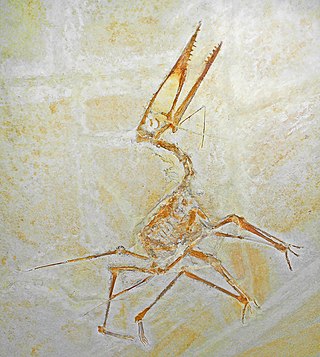
Germanodactylidae is a controversial group of pterosaurs within the suborder Pterodactyloidea. It was first named by Yang Zhongjian in 1964, and given a formal phylogenetic definition in 2014 by Brian Andres, James Clark, and Xu Xing. They defined it as the least inclusive clade containing Germanodactylus cristatus and Normannognathus wellnhoferi, which they considered to be close relatives at the time. However, more recent studies by the same researchers have found that these pterosaurs may be only distantly related.

Eupterodactyloidea is an extinct group of pterodactyloid pterosaurs that existed from the latest Late Jurassic to the latest Late Cretaceous periods. Eupterodactyloids have been found on all continents except Antarctica.
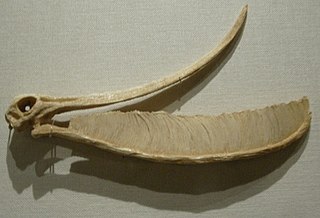
Archaeopterodactyloidea is an extinct clade of pterodactyloid pterosaurs that lived from the middle Late Jurassic to the latest Early Cretaceous periods of Africa, Asia, Europe and North America. It was named by Alexander Wilhelm Armin Kellner in 1996 as the group that contains Germanodactylus, Pterodactylus, the Ctenochasmatidae and the Gallodactylidae. In 2003, Kellner defined the clade as a node-based taxon consisting of the last common ancestor of Pterodactylus, Ctenochasma and Gallodactylus and all its descendants. Although phylogenetic analyses that based on David Unwin's 2003 analysis do not recover monophyletic Archaeopterodactyloidea, phylogenetic analyses that based on Kellner's analyses, or the analyses of Brian Andres recover monophyletic Archaeopterodactyloidea at the base of the Pterodactyloidea.

Novialoidea is an extinct clade of macronychopteran pterosaurs that lived from the latest Early Jurassic to the latest Late Cretaceous, their fossils having been found on all continents except Antarctica.

Ornithocheirae is an extinct clade of pteranodontoid pterosaurs from the Early Cretaceous to the Late Cretaceous of Asia, Europe, North America and South America. It was named by Harry Seeley in 1870 as a family that contains Ornithocheirus and its relatives. The name was emended to Ornithocheiridae, to match the requirements of the ICZN Code that a family-ranked clade should end with an -idae suffix. Brian Andres (2010) in his review of pterosaur phylogeny, defined the name Ornithocheirae phylogenetically, as a node-based taxon consisting of the last common ancestor of Anhanguera and Ornithocheirus and all its descendants. Thus Ornithocheirae is defined to include two families, the Anhangueridae and the Ornithocheiridae, following the opinion of Alexander Kellner and Andres that these families should not be synonymized based on their original phylogenetical definitions. However, subsequent studies in 2019 have found Ornithocheirae to be a more inclusive group containing both Anhangueria and Targaryendraconia.
Alamodactylus is an extinct genus of pteranodontian pterosaur known from the Late Cretaceous of Texas, southern United States. It contains a single species, Alamodactylus byrdi.

Kryptodrakon is an extinct genus of pterodactyloid pterosaur from the Middle to Late Jurassic with an age of approximately 162.7 million years. It is known from a single type species, Kryptodrakon progenitor. The age of its fossil remains made Kryptodrakon the basalmost and oldest pterodactyloid known to date.
